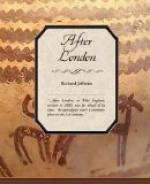Tall beeches, with round smooth trunks, stood thick and close upon the dry and rising ground; their boughs met overhead, forming a green continuous arch for miles. The space between was filled with brake fern, now fast growing up, and the track itself was green with moss. As they came into this beautiful place a red stag, startled from his browsing, bounded down the track, his swift leaps carried him away like the wind; in another moment he left the path and sprang among the fern, and was seen only in glimpses as he passed between the beeches. Squirrels ran up the trunks as they approached; they could see many on the ground in among the trees, and passed under others on the branches high above them. Woodpeckers flashed across the avenue.
Once Oliver pointed out the long, lean flank of a grey pig, or fern-hog, as the animal rushed away among the brake. There were several glades, from one of which they startled a few deer, whose tails only were seen as they bounded into the underwood, but after the glades came the beeches again. Beeches always form the most beautiful forest, beeches and oak; and though nearing the end of their journey, they regretted when they emerged from these trees and saw the castle before them.
The ground suddenly sloped down into a valley, beyond which rose the Downs; the castle stood on a green isolated low hill, about half-way across the vale. To the left a river wound past; to the right the beech forest extended as far as the eye could see. The slope at their feet had been cleared of all but a few hawthorn bushes. It was not enclosed, but a neatherd was there with his cattle half a mile away, sitting himself at the foot of a beech, while the cattle grazed below him.
Down in the valley the stockade began; it was not wide but long. The enclosure extended on the left to the bank of the river, and two fields on the other side of it. On the right it reached a mile and a half or nearly, the whole of which was overlooked from the spot where they had passed. Within the enclosures the corn crops were green and flourishing; horses and cattle, ricks and various buildings, were scattered about it. The town or cottages of the serfs were on the bank of the river immediately beyond the castle. On the Downs, which rose a mile or more on the other side of the castle, sheep were feeding; part of the ridge was wooded and part open. Thus the cultivated and enclosed valley was everywhere shut in with woods and hills.
The isolated round hill on which the castle stood was itself enclosed with a second stockade; the edge of the brow above that again was defended by a stout high wall of flints and mortar, crenellated at the top. There were no towers or bastions. An old and ivy-grown building stood inside the wall; it dated from the time of the ancients; it had several gables, and was roofed with tiles. This was the dwelling-house. The gardens were situated on the slope between the wall and the inner stockade. Peaceful as the scene appeared, it had been the site of furious fighting not many years ago. The Downs trended to the south, where the Romany and the Zingari resided, and a keen watch was kept both from the wall and from the hills beyond.




